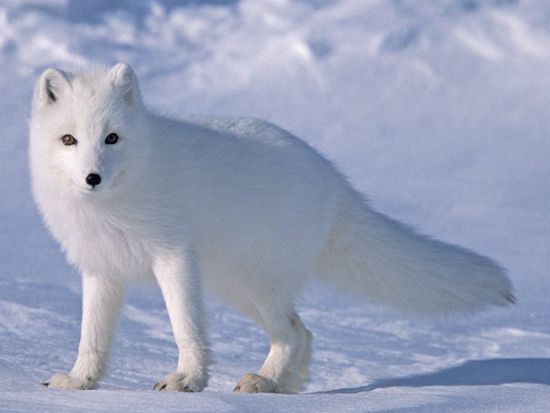
|
迪威国际在线客服-首页 |
|
|||
Products Category |
Arctic foxProduct name : Arctic fox Item : F-02 Details :The arctic fox (Vulpes lagopus), also known as the white fox, polar fox, or snow fox, is a small fox native to the Arctic regions of the Northern Hemisphere and is common throughout the Arctic tundra biome.[1][3] It is well adapted to living in cold environments. It has a deep thick fur which is brown in summer and white in winter. It averages in size at about 85.3 cm (33.6 in) in body length, with a generally rounded body shape to minimize the escape of body heat.
They prey on any small animals they can find, including lemmings, voles, ringed seal pups, fish, seabirds, and bird eggs. They will also eat carrion, berries, and seaweed. They form monogamous pairs during the breeding season and usually stay together in family groups of multiple generations in complex underground dens. The arctic fox lives in some of the most frigid extremes on the planet. Among its adaptations for cold survival is its deep, thick fur, a system of countercurrent heat exchange in the circulation of paws to retain core temperature, and a good supply of body fat. The fox has a low surface area to volume ratio, as evidenced by its generally rounded body shape, short muzzle and legs, and short, thick ears. Since less of its surface area is exposed to the arctic cold, less heat escapes the body. Its furry paws allow it to walk on ice in search of food. The arctic fox has such keen hearing that it can precisely locate the position of prey under the snow. When it finds prey, it pounces and punches through the snow to catch its victim. Its fur changes color with the seasons: in the winter it is white to blend in with snow, while in the summer it is brown. Subspecies: Besides the nominate subspecies, Vulpes lagopus lagopus, there are four other subspecies of this fox:
Characteristics The arctic fox is dark gray to bluish brown in the summer. In the winter its fur is white or creamy white. It has a long bushy tail, a short nose and small curled back ears. It has short, stubby legs and thick fur. Its short legs and nose, thick fur and small ears are adaptations that help it survive in cold climates. Because its legs are so short and its ears and nose are small, they are less exposed to the cold. The arctic fox also has thick fur and hair on its paw pads that help keep it warm. The fur on its paws also gives the fox traction so it doesn't slide on the ice. When the arctic fox is sleeping, it protects its nose from the cold by curling its bushy tail around its body. The arctic fox is about three feet long and weighs between five and fifteen pounds. Males are larger than females.
Diet The arctic fox is an opportunistic eater. It will eat just about whatever it comes across. It eats small mammals like lemmings, voles, and ground squirrels; birds; insects; eggs; berries and carrion. In fact, in the winter it often follows polar bears and wolves and eats their leftover kill. If food is really scarce, it will eat the feces of other animals. In the summer the arctic fox will carry extra food to its den and store it under rocks to eat later. The arctic fox sometimes even makes its own freezer by digging a hole in the permafrost and storing its food there. A major source of food for the arctic fox is the lemming. In fact, the arctic fox population often peaks every four years in a cycle that follows lemming population changes.
Range In North America the arctic fox can be found from western Alaska east through northern Canada in the Northwest Territories, Alberta, Manitoba and Quebec. It is also found in the arctic region s of Europe, Asia, Iceland and Greenland.
Habitat In the summer the arctic fox lives in the tundra at the edge of forest. In the winter it can be found on ice floes where its white coat serves as camouflage. Its den is usually a burrow in a hillside or a bank and it has more than one entrance. In the winter the fox often makes its den in a snowbank.
Life Cycle The arctic fox mates between February and June. The female builds a new den and gives birth to between six to twelve dark furred kits. Both the female and the male will take care of the young kits. The male will guard the den and bring food to the den for the mother and the kits. The kits are weaned when they are between two to four weeks old and then they will start to leave the den.
Behavior The arctic fox is nomadic, it moves from place to place looking for food. In the summer they live in family groups made up of a male, one or two females and the kits. The second female is a leftover kit from the year before, she doesn't breed. She helps care for the young.
Send Inquiry : |
Copyright © 2025 迪威国际在线客服-首页 All Rights Reserved


 Cattle
Cattle  Type Breed Aquatics
Type Breed Aquatics 
